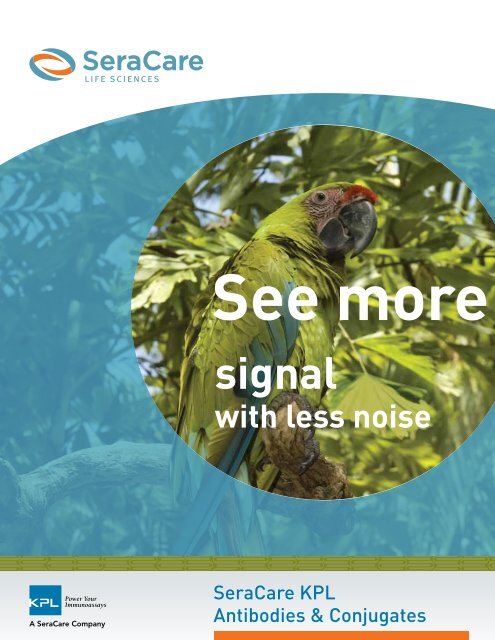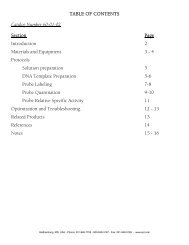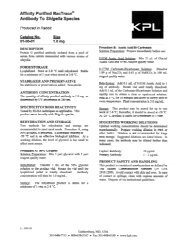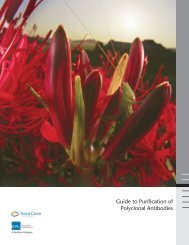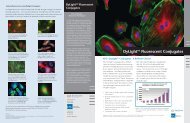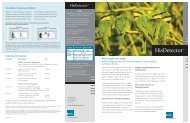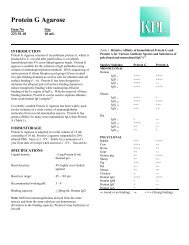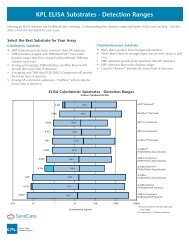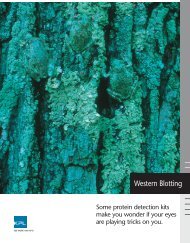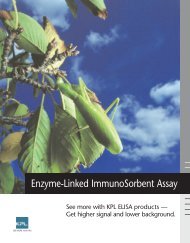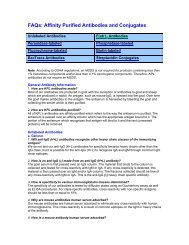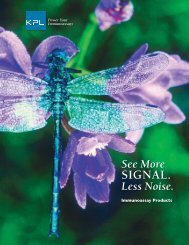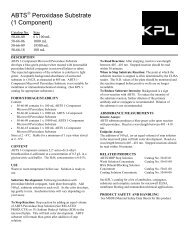KPL Antibodies and Conjugates Catalog
KPL Antibodies and Conjugates Catalog
KPL Antibodies and Conjugates Catalog
Create successful ePaper yourself
Turn your PDF publications into a flip-book with our unique Google optimized e-Paper software.
See moresignalwith less noiseSeraCare <strong>KPL</strong><strong>Antibodies</strong> & <strong>Conjugates</strong>
See more signal with less noiseIn nature many animals use camouflage to escape detection. An animal’s survival oftendepends upon its ability to blend in with its environment, making it difficult to see. Justas in nature, your target protein can also be camouflaged in a complex “environment”,making it difficult to see too. To create a successful immunoassay, you must be able toclearly distinguish your target from background. <strong>KPL</strong> products from SeraCare Life Sciencesimprove immunoassays by increasing the level of specific signal while reducing unwantedbackground. This catalog features animals camouflaged in their environment to illustratethe benefit of our <strong>KPL</strong> products: “See more signal with less noise.” Our products helpresearchers see more <strong>and</strong>, as a result, achieve more.About SeraCare <strong>KPL</strong> ProductsScientists have relied on <strong>KPL</strong> antibodies <strong>and</strong> reagents for nearly four decades. These <strong>KPL</strong>products are now part of SeraCare Life Sciences, a leading provider of critical biologicalproducts to the in vitro diagnostics industry. Our combined product portfolio can meetyour full range of needs from controls <strong>and</strong> calibrators to antibodies, reagents <strong>and</strong> referencematerials.Whether our products are being used by a laboratory researcher or a leading diagnostic kitmanufacturer, SeraCare always adheres to the highest quality st<strong>and</strong>ards. That is why with<strong>KPL</strong> products from SeraCare you see more signal <strong>and</strong> less noise.Contact <strong>KPL</strong><strong>KPL</strong>, a SeraCare Company910 Clopper RoadGaithersburg, MD 20878 USAwww.kpl.comCustomer Service800.638.3167 or +1.301.948.7755, enter 4custserv@kpl.comTechnical Service800.638.3167 or +1.301.948.7755, enter 5techserv@kpl.comContact SeraCareSeraCare Life Sciences37 Birch StreetMilford, MA 01757 USA800.676.1881 or +1.508.244.6400info@seracare.comwww.seracare.comView a list of our international distributors atwww.seracare.com/contact
SERACARE <strong>KPL</strong> ANTIBODIES AND CONJUGATESTable of ContentsWhy Choose SeraCare <strong>KPL</strong> <strong>Antibodies</strong>.................4The Antibody Molecule.................................................... 6Antibody Classes.............................................................. 7Antibody Nomenclature................................................... 7Antibody Purification........................................................ 8Affinity Purification........................................................... 9How <strong>KPL</strong> <strong>Antibodies</strong> Are Purified.................................... 11Choose the Right Antibody for Your Application............. 12Definitions..................................................................... 13SeraCare <strong>KPL</strong> Secondary <strong>Antibodies</strong>.................. 14Unlabeled <strong>Antibodies</strong>..................................................... 15HRP-labeled <strong>Antibodies</strong>.................................................. 16AP-labeled <strong>Antibodies</strong>.................................................... 18ReserveAP -labeled <strong>Antibodies</strong>....................................... 19Biotin-labeled <strong>Antibodies</strong>............................................... 20Gold-labeled <strong>Antibodies</strong>................................................. 21FITC-labeled <strong>Antibodies</strong>................................................. 22TRITC-labeled <strong>Antibodies</strong>............................................... 23R-PE-labeled <strong>Antibodies</strong>.................................................. 23Cy 3-labeled <strong>Antibodies</strong>................................................ 24Why Choose SeraCare BacTrace ® <strong>Antibodies</strong>..... 28SeraCare BacTrace <strong>Antibodies</strong>........................... 30Unlabeled BacTrace <strong>Antibodies</strong>....................................... 30HRP-labeled BacTrace <strong>Antibodies</strong>.................................... 31Biotin-labeled BacTrace <strong>Antibodies</strong>................................. 31DyLight 488-labeled BacTrace <strong>Antibodies</strong>....................... 32FITC-labeled BacTrace <strong>Antibodies</strong>................................... 32AP-labeled BacTrace <strong>Antibodies</strong>...................................... 32ReserveAP-labeled BacTrace <strong>Antibodies</strong>.......................... 32Magnetic Bead-labeled BacTrace <strong>Antibodies</strong>................... 33Latex Bead-labeled BacTrace <strong>Antibodies</strong>......................... 33Positive Controls............................................................ 33SeraCare Custom Solutions............................... 34SeraCare Panels................................................ 37AccuSet Performance Panels........................................ 37AccuSpan Linearity Panels............................................ 37AccuVert Seroconversion Panels................................... 38AccuTrak Qualification Panels....................................... 39Cy5-labeled <strong>Antibodies</strong>.................................................. 24DyLight 405-labeled <strong>Antibodies</strong>................................... 25DyLight 488-labeled <strong>Antibodies</strong>..................................... 25DyLight 594-labeled <strong>Antibodies</strong>..................................... 25DyLight 633-labeled <strong>Antibodies</strong>..................................... 26DyLight 680-labeled <strong>Antibodies</strong>..................................... 26DyLight 800-labeleld <strong>Antibodies</strong>.................................... 27Conjugate Stabilizers...................................................... 27To order, call +1.301.948.7755 or toll free 1.800.638.3167 or visit www.kpl.com3
Why chooseSeraCare <strong>KPL</strong> <strong>Antibodies</strong>Immunoassays are used to quantitatively <strong>and</strong> qualitatively measure smallamounts of analytes in complex biological systems. Although the conceptsbehind the development of an immunoassay may seem straightforward,development of assays that provide false or misleading information iscommon when proper selection of immunoreagents is not a critical part ofthe assay design. The antibody is one of the most important parts of anyimmunoassay design. It is important to select an antibody that provides thegreatest sensitivity <strong>and</strong> specificity with the least amount of non-specific activity.4 To order, call +1.301.948.7755 or toll free 1.800.638.3167 or visit www.kpl.com
SERACARE <strong>KPL</strong> ANTIBODIES AND CONJUGATESThere are many reasons <strong>KPL</strong> polyclonal antibodies are the preferred antibodies in laboratoriesaround the world. Customers appreciate that SeraCare is able to control the entirepurification <strong>and</strong> manufacturing process from raw materials to delivery, including technicalservice <strong>and</strong> support. Unlike resellers, SeraCare has complete control over the purity,specificity, <strong>and</strong> sensitivity of its antibodies.<strong>KPL</strong> antibodies are high-performing. The proprietary purification process eliminates potentiallyinterfering serum proteins <strong>and</strong> non-specific antibodies that increase background<strong>and</strong> cause cross-reactivity issues. As a result, SeraCare is able to offer antibodies with ahigh degree of sensitivity <strong>and</strong> specificity.SeraCare has more than 600 secondary antibodies directed to the immunoglobulins of20 animals species labeled with 18 tags, including enzymes, fluorophores, biotin, <strong>and</strong>microparticles. In addition, SeraCare offers primary antibodies that recognize a variety ofpathogenic bacteria species implicated in food contamination <strong>and</strong> infectious disease.If you need any of these antibodies quickly, we can get them to you. Our antibodies arein-stock <strong>and</strong> ready for same-day shipment. Most <strong>KPL</strong> antibodies are lyophilized <strong>and</strong> canbe shipped worldwide at ambient temperatures.You can be sure when your antibodies arrive they will consistently meet the high st<strong>and</strong>ardsfor quality <strong>and</strong> performance you expect. All products are manufactured using anISO 9001-registered management system to ensure lot-to-lot consistency.SeraCare is an approved antibody supplier <strong>and</strong> trusted source for leading biotech/diagnosticcompanies, as well as academic <strong>and</strong> research laboratories. Many leading manufacturersutilize <strong>KPL</strong> antibodies in a variety of diagnostic kits for AIDS, tropical diseases,food testing, <strong>and</strong> cancer.To order, call +1.301.948.7755 or toll free 1.800.638.3167 or visit www.kpl.com5
SERACARE <strong>KPL</strong> ANTIBODIES AND CONJUGATESThe Antibody Molecule<strong>Antibodies</strong>, which are also referred to as immunoglobulins,are glycoproteins that are produced <strong>and</strong> secretedby B lymphocytes <strong>and</strong> plasma cells. They are producedin animals in response to a foreign substance (antigen).Their ability to bind specifically <strong>and</strong> with great avidityplays a critical role in allowing the immune system todevelop long-term memory <strong>and</strong> protection against aforeign antigen. The high specificity <strong>and</strong> extreme avidityfor a particular antigen are the characteristics thatmake antibodies useful to researchers.The non-antigen binding portion of the antibody,including the hinge region, contains a large part of theheavy chain <strong>and</strong> is called the Fc region (Fragment Crystallizable).While this portion of the antibody cannotbind to antigens, the Fc region plays a significant roll ina number of important immunological reactions in vivo.Due to the similarities of the Fc regions between animalspecies the Fc region can be a source of nonspecificreactions.In order to be able to bind to diverse antigens, antibodiesthemselves need to be diverse, <strong>and</strong> the basic structurereflects this. The antibody is a Y-shaped protein <strong>and</strong> iscomprised of four protein subunits bound together bydisulfide bonds. The subunits are homodimers <strong>and</strong> distinguishedby size. The two smaller subunits are calledlight chains, <strong>and</strong> two larger subunits are called heavychains. One light chain is always associated with oneheavy chain so that the total number of light chains isalways equal to the number of heavy chains for a givenmolecule. The light chain consists of approximately110 amino acids <strong>and</strong> contains a variable region at theC-terminus. The heavy chain has a similar structure of110-amino acid variable region, but is followed by anapproximately 330-amino acid constant region at theN-terminus. The various chains are covalently linked byseveral disulfide bonds in the area of the protein calledthe hinge region.The combined variable regions of the heavy <strong>and</strong> lightchains in the two arms of the Y shape give rise to thebinding site, which is also known as the idiotype. Theportion of the molecule that retains the antigen bindingcharacteristics, the Y part of the antibody, is referred toas the Fab (Fragment Antigen Binding).An antibody can be enzymatically digested into theaforementioned components including one additionalone, F(ab') 2. When an immunoglobulin is digested withpepsin, enzymatic cleavage occurs on the C-terminalside of the disulfide bonds that hold the two heavychains together. This results in two Fab regions that areheld together by sulfide bonds. This is called F(ab') 2.6 To order, call +1.301.948.7755 or toll free 1.800.638.3167 or visit www.kpl.com
SERACARE <strong>KPL</strong> ANTIBODIES AND CONJUGATESAntibody ClassesThere are several classes of antibodies that are calledisotypes. Each isotype is defined functionally by theantigen it specifically recognizes. Mammalian speciesproduce five classes of immunoglobulins, which aredistinguished by physical characteristics, such as structure,size, <strong>and</strong> valency <strong>and</strong> are referred to as IgG, IgM,IgA, IgE, <strong>and</strong> IgD. The composition of the heavy chaindetermines the class of the immunoglobulin. That is,IgG has gamma chains (γ), IgM has mu chains (μ), IgAhas alpha chains (α), IgE has epsilon chains (ε), <strong>and</strong>IgD has delta chains (δ). The specific anti-heavy chainantibodies react with sites on the heavy chain epitopes;for example, the symbol (γ) indicates that antigen willonly react with the gamma heavy chain of the IgG antibody.The light chains also have two different classes.One is known as kappa (κ) <strong>and</strong> the other lambda (λ).IgG can be further subdivided into subclasses basedon slight variation in the amino acid sequence of thegamma heavy chain. For example, human IgG can bedivided into IgG1, IgG2, IgG3, <strong>and</strong> IgG4. Mouse IgGcan be divided into IgG1, IgG2a, IgG2b, <strong>and</strong> IgG3.Other species have similar subdivisions.Antibody Class FunctionIgG <strong>Antibodies</strong>: IgG is the dominant antibody foundin blood serum. IgG promotes the recognition of microorganismsby immune cells <strong>and</strong> is responsible for longtermprotection from disease. This antibody is the mainimmunoglobulin used in various immunoassays.IgM <strong>Antibodies</strong>: IgM is the first antibody produced inresponse to infection. It is very effective in activatingcomplement <strong>and</strong> destroying bacteria. IgM has a pentamericstructure <strong>and</strong> is held together by extra disulfidebonds formed near the C-terminal end of the heavychains plus a short polypeptide referred to as the Jchain. Serum IgM is often analyzed in assays for earlydetection of infection.IgA <strong>Antibodies</strong>: IgA is known as the secretory antibody<strong>and</strong> is found in mucous membrane secretions, like saliva.It protects the respiratory <strong>and</strong> gastrointestinal tracts frominfection <strong>and</strong>, in some mammals, IgA is a major factorin milk that passively protects newborns. IgA is a dimer<strong>and</strong> is held together by a secretory chain.IgE <strong>Antibodies</strong>: IgE binds to the Fc receptors on mastcells <strong>and</strong> basophils <strong>and</strong> triggers the allergic response.The IgE antibody is also associated with defense againstparasites. IgE is present in blood in extremely low concentrations.Typically, anti-IgE is used in allergy testing.IgD <strong>Antibodies</strong>: IgD is a minor blood component <strong>and</strong>is typically bound to the surface of B lymphocytes.Antibody NomenclatureSecondary antibodies are usually identified with thefollowing:• the species from which they originate (e.g., goat,mouse, rat, hamster, etc.),• the species whose antibodies they are designed tobind to or react with (e.g., human, mouse, etc.),• the class (e.g., IgA, IgD, IgE, IgG, IgM) or subclass(IgG1, IgG2a, etc.) of antibodies of thespecies to which they are designed to bind,• whether they are monoclonal or polyclonal,• whether they are enzymatically processed intofragments, <strong>and</strong>• whether they are conjugated.Additionally, some names will indicate:• specific antibody chains that are recognized[e.g., heavy (H), light (L), kappa (κ), lambda (λ)],• they have been affinity purified out of serum,• they have been adsorbed to other antibodies toreduce cross-reactivity, or• they are cross-reactive to antibodies of otherspecies or other antibody classes <strong>and</strong> subclasses.For example, “Goat Anti-Human IgG (H+L) HRP-labeledAntibody” would be used to identify an antibody thatwas produced in goats, that has epitopes on both theheavy <strong>and</strong> light chains of human IgG that will be recognized,<strong>and</strong> that the antibody is conjugated to horseradishperoxidase (HRP). The majority of <strong>KPL</strong> antibodiesare produced in goats. Therefore, only when they arenot produced in goats is the host animal included in theantibody names.To order, call +1.301.948.7755 or toll free 1.800.638.3167 or visit www.kpl.com7
YYYYYYYYYYYYYYYYYYYYYYYYYYYYYYYYSERACARE <strong>KPL</strong> ANTIBODIES AND CONJUGATESAntibody PurificationWhen choosing a polyclonal antibody, either as aprimary or secondary antibody in an immunoassay,researchers are often inundated with an array of antibodypurification terms that they may not know muchabout. Underst<strong>and</strong>ing polyclonal antibody purificationsteps gives researchers the opportunity to pick the mostappropriate antibody purification technique for theirparticular immuno-application.Today, most polyclonal antibodies are referred to asbeing affinity purified. There are three major types ofaffinity purification: immunoglobulin-specific purification,antigen-specific purification, <strong>and</strong> serum adsorption.It should be noted that the different types ofpurification schemes are often used in combination toproduce a better antibody. But first, it is important tounderst<strong>and</strong> the early steps, serum purification <strong>and</strong> saltprecipitation.Serum PurificationPolyclonal secondary antibodies may be provided as aserum fraction. Serum is the amber colored supernatantobtained after blood is allowed to clot <strong>and</strong> is the simplestpurification technique. Serum contains different types ofantibodies as well as antibodies with a variety of affinities,some of which will bind to the antigen of interest <strong>and</strong>some of which will bind to non-specific antigens. Serumis inexpensive <strong>and</strong> provides sensitivity, but not reliablespecificity. In fact, serum will likely contain less than10% specific antibody. The lack of specificity is due to amultitude of antibody clones <strong>and</strong> other proteins, includingalbumin, which may bind non-specifically in an immunoassay.Serum will often be found in individual labsprovided by researchers developing their own antibodies.Salt PrecipitationOne common technique for purifying proteins is saltprecipitation. The solubility of proteins is related to thesalt concentration of the solution. Increasing the amountof salt in a solution essentially removes water moleculesfrom the protein, causing the protein to precipitate. Thisis commonly called “salting out.” The differences in composition<strong>and</strong> shape of proteins mean that proteins precipitateat varying concentrations of salt. Often proteinsare precipitated in a two-step or fractionated process. Inthe first step, salt is added so that the antibody of interestremains soluble, <strong>and</strong> unwanted proteins are removed.In the second step, more salt is added so that the antibodyof interest precipitates, <strong>and</strong> the unwanted solubleproteins can be removed. The precipitate is then dialyzedto remove the salt, <strong>and</strong> the antibody dissolved backinto solution. Serum can be precipitated this way usingammonium sulfate or caprylic acid. Salt precipitationis an inexpensive way to purify antibody from serum;however, the process does not remove proteins with aprecipitation pattern similar to antibodies.Step 1Serum with antibodies (Y)Extra proteins ( )Step 2Serum with antibodies (Y)Extra proteins ( )Low Salt PrecipitationYYYYYYYYYYYYYYYYYYYLow [salt]High [salt]CentrifugationSalt is added, forcing unwanted proteins to precipitate.Y YY YYHigh Salt PrecipitationYYYYYYYYYYYYYCentrifugationY YY YYYYYYYYYYYYYYYYYYYYYYYYYYYYYYYYYYIncreasing the salt concentration eventually leads to antibody precipitation.BloodYYYYYYCentrifugationYYYYYYYYSerum with antibodiesYYYYBlood cellsAfter clotting, whole blood is centrifuged to separate serum fromother components.8 To order, call +1.301.948.7755 or toll free 1.800.638.3167 or visit www.kpl.com
SERACARE <strong>KPL</strong> ANTIBODIES AND CONJUGATESAffinity PurificationThere are three types of affinity purification. Many times,the three are used in combination when the purest antibodyis needed.Immunoglobulin-Specific Affinity PurificationIn certain bacteria, immunoglobulin-binding proteins areused to evade the host immune response. These proteinsbind immunoglobulins in an orientation that preventsnormal antibody function. Repurposed for purification,immunoglobulin-binding proteins are used to increasethe purity or to concentrate an antibody solution.There are three common immunoglobulin-bindingproteins used to purify antibodies, Protein A, Protein G,<strong>and</strong> Protein L. Protein A (from Staphylococcus aureus) <strong>and</strong>Protein G (from Streptococcus spp.) bind to the Fc regionof antibodies while Protein L (from Peptostreptococcusmagnus) binds to the antibodies through the light chain.Often these proteins are immobilized to a solid support(e.g., agarose beads) to form affinity matrices. Protein A,Protein G, <strong>and</strong> Protein L all have unique immunoglobulin-bindingcharacteristics according to species, antibodytype, <strong>and</strong> antibody isotype. Care must be taken when selectingan immunoglobulin-specific purification to makesure the antibody of interest will actually bind to theimmunoglobulin-binding protein. Because the techniquedoes not isolate antigen-specific antibodies, immunoassaysusing immunoglobulin-purified antibodies may stillhave background or specificity issues.Antigen Affinity Purification (Positive)Antigen affinity purification is another specific type ofaffinity purification <strong>and</strong> results in the purest antibodieswith the least amount of cross-reactivity. Affinity purifiedantibodies exhibit the highest specificity <strong>and</strong> sensitivitythat can be obtained from serum. Because these antigenspecificantibodies are polyclonal, they can be usedas both the capture <strong>and</strong> detection antibody in capture(s<strong>and</strong>wich) immunoassays.Despite all the care used to purify antibodies against aspecific antigen there are some epitopes that are sharedbetween proteins. These shared epitopes can causecross-reactivity. In order to remove the cross-reactivity,negative affinity selection is utilized. Negative affinitypurification selection is similar to antigen affinity purificationexcept that unwanted proteins are used to removecross-reacting antibodies. Often the unwanted proteinsare attached to a solid support, <strong>and</strong> an affinity column isconstructed using the cross-reacting antigen. During thepurification process a negative affinity column is utilizedto remove the unwanted antibody. Negative selection canbe performed one or more times depending on the levelof purity needed. The caveat to negative affinity columnsis that the total number of epitopes being recognizedby the polyclonal antibody is being reduced, <strong>and</strong> thus,the sensitivity will begin to decrease. A tradeoff must bemade between sensitivity <strong>and</strong> specificity.It should be noted that immunoglobulin-specific purificationis a specific type of affinity purification; however,manufacturers often do not distinguish between ProteinA, Protein G, or Protein L purification versus antigen affinitypurification.YAnti-Mouse IgGNonspecific Proteins<strong>and</strong> ImmunoglobulinsColumn BoundMouse IgG EpitopesYYYY YYYYYYYAntibodyAgaroseBeadProtein A or GAntigen-specific antibodies bind to column matrix.To order, call +1.301.948.7755 or toll free 1.800.638.3167 or visit www.kpl.com9
SERACARE <strong>KPL</strong> ANTIBODIES AND CONJUGATESSerum Adsorption (Negative Affinity Purification)Polyclonal antibodies are most commonly used asanti-immunoglobulin secondary antibodies in variousimmunoassays. Even though polyclonal antibodies oftendisplay higher sensitivity than monoclonal antibodies,they can suffer from a lack of specificity. In certainapplications even antigen affinity purified antibodiesmay suffer from a lack of specificity. Despite beingaffinity purified as species-specific, anti-immunoglobulinscan bind other species to varying degrees due toshared epitopes across species. Depending on the immunoassays,researchers may need this cross-reactivityremoved. Traditionally, the cross-reactivity was removedby adding serum of the unwanted species. Thecross-reacting antibodies bound to the serum <strong>and</strong> wereremoved from the total antibody pool. Cross adsorptionis easy to perform but introduces a complex proteinmixture of serum from a different species back intoa relative pure antibody solution. The antibody mustthen be repurified.YYCross-ReactingAnti-Mouse IgGAnti-Mouse IgGColumn BoundCross-Reacting AntigenYYYYYYYYY YYCross-reacting antibodies bind to column matrix.YYYYYYY YYY YY YYYWhile the above technique is historically valid, thesedays most manufactures of secondary antibodies attachserum to a solid support <strong>and</strong> make negative affinitycolumns from serum. Thus serum adsorption is bettercategorized as a specific type of negative affinity, ratherthan a purification technique. Despite the wide use ofnegative affinity for purification purposes, manufacturershave traditionally only listed which antibodies havebeen serum adsorbed because knowledge of serumadsorption is critical for researchers performing multiplexassays.10 To order, call +1.301.948.7755 or toll free 1.800.638.3167 or visit www.kpl.com
SERACARE <strong>KPL</strong> ANTIBODIES AND CONJUGATESHow <strong>KPL</strong> <strong>Antibodies</strong> Are PurifiedThe proprietary purification technology used results inhigher affinity antibodies, which increase sensitivity <strong>and</strong>reduce background. Selected antibodies may be purifiedusing negative affinity columns to minimize cross-reactivitybetween animal species or to reduce shared reactivity withother immunoglobulin classes. These processes yieldpure antibodies with defined specificities <strong>and</strong> result inconsistent lot-to-lot performance.Considerable effort is spent developing <strong>and</strong> purifyingan antigen formulation to generate high titer, specificantiserum, since pure antigen results in a more potent<strong>and</strong> specific antibody.ImmunizationPrior to immunization, animals are carefully screenedfor reactivity toward the antigen. This allows thescreening out of animals that will not produce aneffective antibody. Next, multiple animals are involvedin the production of one antibody, thus allowing forthe collection the most potent antibodies possible. Inaddition, pooling antiserum from multiple animalsminimizes natural serum variability, resulting in uniformlarge-scale antibody lots.Production bleeds are obtained from the animals <strong>and</strong>are screened for potency. Production bleeds that do notmeet quality requirements are rejected. The immunoglobulinfraction of antisera is then isolated <strong>and</strong> testedfor purity as well as potency against the antigen.PurificationEven with the purity testing, the antiserum will containmany lipids <strong>and</strong> serum proteins. The most prevalentamong them is albumin, which accounts for 50% of theprotein in serum. The first step in the affinity purificationprocess is accomplished by a series of salt precipitationsteps in which 99% of these substances are removed.The resultant immunoglobulin fraction is likelyto contain only 5-10% specific antibody. At this point,affinity purification using both positive <strong>and</strong> negativeselection is utilized to purify the specific antibody fromthe nonspecific antibody. Then, the antibody is testedagain for potency <strong>and</strong> cross-reactivity.Species Cross-ReactivityImmunoglobulins of related animal species often sharesimilar epitopes derived from homologous proteinstructure <strong>and</strong> sequence. For example, affinity purifiedantibodies against mouse IgG may recognize epitopeson human IgG. To minimize cross-reactivity betweenmouse <strong>and</strong> human species, antibodies to mouse immunoglobulinare adsorbed against immobilized humanserum on a negative affinity column. The resultingantibody, anti-mouse IgG, human serum adsorbed(HSA), is highly specific to mouse IgG with minimalreactivity to human IgG or to any other human serumcomponents. Select antibody preparations are furtheradsorbed against multiple animal species to reducereactivity to shared regions among these species.Heavy <strong>and</strong> Light Chain Cross-ReactivityPolyclonal antibodies recognize different regions on IgGheavy <strong>and</strong> light chains. Some of these regions are similarto IgA <strong>and</strong> IgM heavy <strong>and</strong> light chains. Therefore,these antibodies consist of subpopulations that also recognizeIgM <strong>and</strong> IgA. To make an antibody specific forthe IgG heavy chain, these subpopulations need to beremoved or reduced. To do this, the purified antibodiesare passed over a negative affinity column with immobilizedwhole IgM <strong>and</strong> IgA antibodies containing bothheavy <strong>and</strong> light chains. <strong>Antibodies</strong> that recognized IgM<strong>and</strong> IgA bind to the column while antibodies specificfor the IgG heavy chain pass through <strong>and</strong> are collected.The Finished ProductThe final purified antibody is characterized for potency<strong>and</strong> specificity by two distinct ELISA formats <strong>and</strong> forpurity by SDS-PAGE. After the testing is complete, thepurified antibody is lyophilized <strong>and</strong> undergoes onemore round of testing for potency <strong>and</strong> solubility.To order, call +1.301.948.7755 or toll free 1.800.638.3167 or visit www.kpl.com11
SERACARE <strong>KPL</strong> ANTIBODIES AND CONJUGATESChoose the Right Antibodyfor your applicationIt is important to know how different antibodies will performin different immunoassays. Below are descriptions ofthe general antibody characteristics to help you determinewhich is the best antibody for your immunoassay.Anti-Heavy <strong>and</strong> Light Chain (H+L) <strong>Antibodies</strong><strong>Antibodies</strong> to IgG heavy <strong>and</strong> light chains (H+L) recognizeepitopes on both heavy <strong>and</strong> light chains of IgG<strong>and</strong> may react with other immunoglobulin classes thathave light chains in common with IgG. These antibodiesare versatile choices for many different assays. H+Lantibodies will recognize the most epitopes <strong>and</strong> thuswill give the maximum amount of signal.Anti-Heavy Chain-Specific <strong>Antibodies</strong>Anti-heavy chain-specific antibodies, IgG (γ), IgM (μ),IgA (α), <strong>and</strong> IgE (ε), react specifically with the heavychain indicated in the product name. Heavy chainspecificantibodies are absorbed against the wholeantibody molecule of other immunoglobulin classesto remove shared heavy <strong>and</strong> light chain reactivity. Forexample, gamma-specific products are cross-reacted onresins containing species-specific IgM <strong>and</strong> IgA antigens.These antibodies are useful in assays where “heavychain only” reactivity is desired.Anti-IgG+IgM (H+L) <strong>Antibodies</strong>Antibody products directed against IgG <strong>and</strong> IgM (H+L)contain an equal mixture of two antibodies that recognizereactive sites specific for IgG <strong>and</strong> IgM. Theseantibodies are recommended when monitoring bothIgG <strong>and</strong> IgM.Anti-IgA+IgG+IgM (H+L) <strong>Antibodies</strong><strong>Antibodies</strong> directed against IgA+IgG+IgM (H+L) containan equal mixture of three antibodies that recognizereactive sites specific to IgA, IgG, <strong>and</strong> IgM. Othershared sites through light chain cross-reactivity alsomay be present. Anti-IgA+IgG+IgM (H+L) antibodiesare best used when measurement of all three classes ofantibodies needs to be controlled in an immunoassay.F(ab') 2Fragment <strong>Antibodies</strong>F(ab') 2fragment antibodies are specifically developedto prevent the antibody binding non-specifically toFc receptors located on some types of cells. F(ab') 2antibodies can also be used to reduce background inassays that involve bacterial contamination or detectionof antigens in cell lysates. F(ab') 2antibodies also canbe used to increase sensitivity in immunohistochemicalapplications where smaller antibody molecules areneeded to diffuse through tissues.12 To order, call +1.301.948.7755 or toll free 1.800.638.3167 or visit www.kpl.com
SERACARE <strong>KPL</strong> ANTIBODIES AND CONJUGATESDefinitionsAntigen An antigen is a molecule that is capable ofprovoking the production of antibodies. The antigen<strong>and</strong> antibody bind much like a lock <strong>and</strong> key system.Antigens are usually large. In some cases, they are proteinsthat are larger than the antibody. They can also beorganisms such as bacteria or viruses.Antiserum A pool of blood serum that contains all ofthe antibody fraction plus other serum proteins.Epitopes The structural area on an antigen that bindswith an antibody.Fab Fab st<strong>and</strong>s for fragment antigen binding. It is theportion of the antibody that is comprised of the heavy<strong>and</strong> light chain of one arm of the Y shape. The Fab containsthe variable sections that define the specific targetto which the antibody can bind.Fc The fragment crystallizable is the tail region of anantibody that interacts with cell surface receptors calledFc receptors.F(ab') 2When IgG is digested with pepsin, enzymaticcleavage occurs on the C-terminal side of the disulfidebonds that hold the two heavy chains together. Thisresults in two Fab regions that are held together bydisulfide bonds <strong>and</strong> is referred to as F(ab') 2.Heavy chain The heavy chain has a structureof 110-amino acids followed by an approximately330-amino acid constant region. The heavy chain designatesthe isotope, IgM, IgG, IgD, IgE, <strong>and</strong> IgA. It alsodetermines the subclass.Immunogen An immunogen is a foreign substance(non-self)—such as a protein, lipid, or carbohydrate—introduced into a host animal that provokes an immuneresponse. An immunogen is also a specific typeof antigen. All immunogens are antigens but not allantigens are immunogens.Light chain The light chain consists of approximately110 amino acids at the C-terminal end <strong>and</strong> is referredto as the variable region. There are two types of lightchains, λ <strong>and</strong> κ.Monoclonal Monoclonal antibodies are producedfollowing the fusion of myeloma cells with B cells. Theresultant continuous cell line (hybridoma) produceslarge quantities of homogeneous, well-defined, singleepitope antibody. The availability of large quantities ofcontinuously produced antibody allow for greater st<strong>and</strong>ardization<strong>and</strong> quality control of the antibody reagent.Therefore, monoclonal antibodies are more preciselycharacterized <strong>and</strong> have greater acceptance by regulatoryagencies when used in diagnostic application.Primary Antibody A primary antibody is an antibodyused to detect another type of molecule. The antibodycan be monoclonal or polyclonal. What makes primaryantibodies extremely useful is their ability to bind withhigh affinity <strong>and</strong> specificity to unique epitopes acrossa broad spectrum of biomolecules. While primaryantibodies are sometimes labeled, researchers will oftenuse an unlabeled primary antibody in conjunction witha labeled secondary antibody to provide a signal enhancement.Historically, the term primary antibody wasthe first antibody applied to the substrate-bound targetmolecule in the assay detection process. With today’snewer array types of assays, this convention does notnecessarily hold true.Polyclonal Polyclonal antibodies are obtained fromthe serum of animals immunized with a particularantigen. The antibody pool obtained from serum is theresult of many B cell clones to one specific antibody.Therefore, polyclonal antibodies represent a mixture ofinnumerable distinct clones. The antibodies recognizemultiple epitopes or have multiple binding sites on aparticular antigen.Secondary Antibody A secondary antibody refersto an antibody that detects another antibody. They areusually conjugated to an enzyme, fluorophore, or othertag. While monoclonals can be used, polyclonal antibodiesprovide signal amplification by binding multipleepitopes on the primary antibody.Serum Plasma that does not contain blood clottingfactors, or fibrinogen.To order, call +1.301.948.7755 or toll free 1.800.638.3167 or visit www.kpl.com13
SERACARE <strong>KPL</strong> ANTIBODIES AND CONJUGATESBiotin-labeled <strong>Antibodies</strong> continued<strong>Catalog</strong> No.Size<strong>Catalog</strong> No.SizeAnti-Mouse continuedAnti-RatIgM (μ), HSA 16-18-03 0.5 mgIgA+IgG+IgM (H+L), HSA 16-18-07 0.5 mgIgG+IgM (H+L), HSA 16-18-09 0.5 mgAnti-RabbitIgG (H+L) 16-15-06 0.5 mg176-1506 2.0 mg71-00-30 50 mLIgG (H+L), HSA 16-15-16 0.5 mgIgG (γ) 16-16-02 0.5 mgIgG (H+L) 16-16-06 0.5 mg71-00-31 50 mLIgG (H+L), MSA 16-16-12 0.5 mgIgM (μ) 16-16-03 0.5 mgRabbit Anti-SheepIgG (H+L) 16-23-06 0.5 mgAnti-SwineIgG (γ) 16-14-02 0.5 mgIgM (μ) 16-14-03 0.5 mgGold-labeled <strong>Antibodies</strong>Anti-Human<strong>Catalog</strong> No.SizeIgG (H+L) 58-10-06* 1.0 mL57-10-06** 3.0 mLAnti-RabbitIgG (H+L) 58-15-06* 1.0 mL57-15-06** 3.0 mLAnti-Biotin 58-40-06* 1.0 mL57-40-06** 3.0 mLStreptavidin 58-30-06* 1.0 mL* 5 nm** 40 nmTo order, call +1.301.948.7755 or toll free 1.800.638.3167 or visit www.kpl.com21
SERACARE <strong>KPL</strong> ANTIBODIES AND CONJUGATESDyLight 633-labeled <strong>Antibodies</strong>Anti-Human<strong>Catalog</strong> No.SizeIgG (H+L), F(ab') 2202-10-10-06 1.0 mgAnti-MouseIgG (H+L), F(ab') 2, HSA 202-10-18-06 1.0 mgDyLight 680-labeled <strong>Antibodies</strong><strong>Catalog</strong> No.Size<strong>Catalog</strong> No.SizeAnti-ChickenAnti-RabbitIgG (H+L) 072-06-24-06 1.0 mgRabbit Anti-GoatIgG (H+L) 072-06-13-06 1.0 mgAnti-HumanIgG (H+L) 072-06-10-06 1.0 mg042-06-10-06 0.1 mgAnti-MouseIgG (H+L), HSA 072-06-18-06 1.0 mg042-06-18-06 0.1 mgIgG (H+L), RbSA, HSA 072-06-18-18 1.0 mgIgG (H+L) 072-06-15-06 1.0 mg042-06-15-06 0.1 mgIgG (H+L), HSA 072-06-15-16 1.0 mgIgG (H+L), F(ab') 2, HSA 202-06-15-16 1.0 mgAnti-RatIgG (H+L) 072-06-16-06 1.0 mgStreptavidin 072-06-30-00 1.0 mg042-06-30-00 0.1 mg26 To order, call +1.301.948.7755 or toll free 1.800.638.3167 or visit www.kpl.com
SERACARE <strong>KPL</strong> ANTIBODIES AND CONJUGATESBacTrace antibodies are prepared by a proprietary method that yields highly characterizedantibodies with excellent specificity <strong>and</strong> sensitivity. As such, the antibodies offer a rangeof benefits in the development of high-performance immunoassays. BacTrace affinity purifiedantibodies offer excellent specificity <strong>and</strong> sensitivity in immunoassays such as ELISA,Western blot, lateral flow, agglutination, flow cytometry, <strong>and</strong> immunofluorescence. Sincethey are more sensitive than many commercially available monoclonal antibodies, Bac-Trace antibodies are ideal for use in the research laboratory, for environmental monitoring,<strong>and</strong> for food <strong>and</strong> beverage analysis.With <strong>KPL</strong> BacTrace antibodies, researchers can count on:• Enhanced sensitivity - Affinity purified polyclonal antibodies provide maximaldetection of the antigen of interest. They recognize a variety of cell surface <strong>and</strong>intracellular antigens of bacterial cells, thereby greatly amplifying the signalcompared to monoclonal antibodies.• Excellent specificity - Affinity purification selects for the antibody of interest <strong>and</strong>enables production of antibodies with high specificity for the target antigen <strong>and</strong>minimal cross-reactivity.• Lot-to-lot reproducibility - High correlation between antibody lots is verified byextensive in-house testing.BacTrace antibodies are available unlabeled <strong>and</strong> labeled with enzymes, fluorophores,magnetic beads <strong>and</strong> other tags for use in ELISA, Western blot, immunohistochemistry orfluorescence microscopy. Positive control antigens are also available. <strong>KPL</strong>’s line of primarypolyclonal antibodies consists of 28 antibodies with 9 different tags.To order, call +1.301.948.7755 or toll free 1.800.638.3167 or visit www.kpl.com29
SERACARE <strong>KPL</strong> ANTIBODIES AND CONJUGATESUnlabeled BacTrace <strong>Antibodies</strong><strong>Catalog</strong> No.Size<strong>Catalog</strong> No.SizeHuman PathogensCommunicable PathogensFood-borne PathogensAnti-Campylobacter species 01-92-93 1.0 mgAnti-E. coli O103 01-95-93 1.0 mgAnti-Helicobacter pylori 01-93-94 1.0 mgAnti-Staphylococcus aureus 01-90-05 1.0 mg011-90-05 0.1 mg011-95-93 0.1 mgAnti-E. coli O104 01-95-98 1.0 mg011-95-98 0.1 mgAnti-E. coli O111 01-95-91 1.0 mg011-95-91 0.1 mgAnti-Streptococcus pyogenes(Group A)Anti-Streptococcus agalactiae(Group B)Zoonotic Pathogens01-90-07 1.0 mg011-90-07 0.1 mg01-90-08 1.0 mg011-90-08 0.1 mgAnti-E. coli O121 01-95-95 1.0 mg011-95-95 0.1 mgAnti-E. coli O145 01-95-94 1.0 mg011-95-94 0.1 mgAnti-E. coli O157:H7 01-95-90 1.0 mgAnti-E. coli O157:H7,Molecular Grade01-95-90-MG1.0 mgAnti-E. coli O26 01-95-92 1.0 mg011-95-92 0.1 mgAnti-E. coli O45 01-95-96 1.0 mgAnti-Borrelia burgdorferi 01-97-91 1.0 mgAnti-Borrelia species 01-97-92 1.0 mgRabbit Anti-Yersinia species 01-90-04 1.0 mgEnvironmental PathogensRabbit Anti-Legionella species 01-90-03 1.0 mgAnimal PathogensAnti-RenibacteriumsalmoninarumPlant PathogensRabbit Anti-Clavibactermichiganensis ssp. michiganensis01-96-91 1.0 mg01-90-51 1.0 mg011-90-51 0.1 mg011-95-96 0.1 mgAnti-E. coli O91 01-95-99 1.0 mg011-95-99 0.1 mgAnti-Listeria species 01-90-90 1.0 mgAnti-Listeria species,High SensitivityAnti-Salmonella CommonStructural Antigen (CSA-1)Anti-Salmonella (CSA-1),Molecular Grade01-90-95 1.0 mg01-91-99 1.0 mg01-91-99-MG 1.0 mgRabbit Anti-Shigella species 01-90-01 1.0 mgRabbit Anti-Vibrio cholerae 01-90-50 0.5 mgRabbit Anti-Vibrio species 01-90-02 1.0 mg30 To order, call +1.301.948.7755 or toll free 1.800.638.3167 or visit www.kpl.com
SERACARE <strong>KPL</strong> ANTIBODIES AND CONJUGATESHRP-labeled BacTrace <strong>Antibodies</strong>Human PathogensFood-borne Pathogens<strong>Catalog</strong> No.SizeAnti-Campylobacter species 04-92-93 0.1 mgAnti-E. coli O103 04-95-93 0.1 mgAnti-E. coli O111 04-95-91 0.1 mgAnti-E. coli O121 04-95-95 0.1 mgAnti-E. coli O145 04-95-94 0.1 mgAnti-E. coli O157:H7 04-95-90 0.1 mgAnti-E. coli O26 04-95-92 0.1 mgAnti-E. coli O45 04-95-96 0.1 mgAnti-Listeria species 04-90-90 0.1 mgAnti-Salmonella CommonStructural Antigen (CSA-1)04-91-99 0.1 mgFood-borne Pathogenscontinued<strong>Catalog</strong> No.SizeRabbit Anti-Vibrio species 04-90-02 0.1 mgCommunicable PathogensAnti-Helicobacter pylori 04-93-94 0.1 mgZoonotic PathogensAnti-Borrelia burgdorferi 04-97-91 0.1 mgAnti-Borrelia species 04-97-92 0.1 mgRabbit Anti-Yersinia species 04-90-04 0.1 mgEnvironmental PathogensRabbit Anti-Legionella species 04-90-03 0.1 mgAnimal PathogensAnti-Renibacteriumsalmoninarum04-96-91 0.1 mgRabbit Anti-Shigella species 04-90-01 0.1 mgBiotin-labeled BacTrace <strong>Antibodies</strong><strong>Catalog</strong> No. SizeHuman PathogensFood-borne PathogensAnti-E. coli O103 16-95-93 0.5 mgAnti-E. coli O111 16-95-91 0.5 mgAnti-E. coli O121 16-95-95 0.5 mgAnti-E. coli O145 16-95-94 0.5 mgAnti-E. coli O157:H7 16-95-90 0.5 mgAnti-E. coli O26 16-95-92 0.5 mgAnti-E. coli O45 16-95-96 0.5 mgFood-borne Pathogenscontinued<strong>Catalog</strong> No.SizeAnti-Listeria species 16-90-90 0.5 mgAnti-Salmonella CommonStructural Antigen (CSA-1)16-91-99 0.5 mgRabbit Anti-Shigella species 16-90-01 0.5 mgRabbit Anti-Vibrio species 16-90-02 0.5 mgZoonotic PathogensRabbit Anti-Yersinia species 16-90-04 0.5 mgEnvironmental PathogensRabbit Anti-Legionella species 16-90-03 0.5 mgTo order, call +1.301.948.7755 or toll free 1.800.638.3167 or visit www.kpl.com31
SERACARE <strong>KPL</strong> ANTIBODIES AND CONJUGATESDyLight 488-labeled BacTrace <strong>Antibodies</strong>AP-labeled BacTrace <strong>Antibodies</strong><strong>Catalog</strong> No.Size<strong>Catalog</strong> No.SizeHuman PathogensHuman PathogensFood-borne PathogensFood-borne PathogensAnti-E. coli O103 072-03-95-93 0.5 mgAnti-E. coli O111 072-03-95-91 0.5 mgAnti-E. coli O121 072-03-95-95 0.5 mgAnti-Borrelia burgdorferi 05-97-91 0.1 mgAnti-Campylobacter species 05-92-93 0.1 mgAnti-E. coli O157:H7 05-95-90 0.1 mgAnti-E. coli O145 072-03-95-94 0.5 mgAnti-E. coli O26 072-03-95-92 0.5 mgAnti-E. coli O45 072-03-95-96 0.5 mgRabbit Anti-Shigella species 072-03-90-01 0.5 mgAnti-Salmonella CommonStructural Antigen (CSA-1)Animal PathogensAnti-Renibacteriumsalmoninarum05-91-99 0.1 mg05-96-91 0.1 mgRabbit Anti-Vibrio species 072-03-90-02 0.5 mgZoonotic PathogensRabbit Anti-Yersinia species 072-03-90-04 0.5 mgEnvironmental PathogensRabbit Anti-Legionella species 072-03-90-03 0.5 mgFITC-labeled BacTrace <strong>Antibodies</strong>ReserveAP-labeled BacTrace <strong>Antibodies</strong>*<strong>Catalog</strong> No.Size<strong>Catalog</strong> No.SizeHuman PathogensHuman PathogensFood-borne PathogensFood-borne PathogensAnti-Campylobacter species 02-92-93 0.5 mgAnti-E. coli O157:H7 02-95-90 0.5 mgAnti-Listeria species 02-90-90 0.5 mgAnti-Listeria species 051-90-90 0.1 mgZoonotic PathogensAnti-Borrelia burgdorferi 051-97-91 0.1 mgAnti-Salmonella CommonStructural Antigen (CSA-1)Communicable Pathogens02-91-99 0.5 mgAnti-Helicobacter pylori 02-93-94 0.5 mgZoonotic PathogensAnti-Borrelia burgdorferi 02-97-91 0.5 mgAnti-Borrelia species 02-97-92 0.5 mgAnimal PathogensAnti-Renibacteriumsalmoninarum02-96-91 0.5 mg * Highest grade of AP combined with <strong>KPL</strong>’s proprietaryconjugation technology creates most sensitive conjugates.32 To order, call +1.301.948.7755 or toll free 1.800.638.3167 or visit www.kpl.com
SERACARE <strong>KPL</strong> ANTIBODIES AND CONJUGATESMagnetic Bead-labeled BacTrace <strong>Antibodies</strong>Latex Bead-labeled BacTrace <strong>Antibodies</strong><strong>Catalog</strong> No.Size<strong>Catalog</strong> No.SizeHuman PathogensHuman PathogensFood-borne PathogensFood-borne PathogensAnti-E. coli O103 082-01-95-93 1.0 mLAnti-E. coli O111 082-01-95-91 1.0 mLAnti-E. coli O121 082-01-95-95 1.0 mLAnti-E. coli O145 082-01-95-94 1.0 mLAnti-E. coli O157:H7 082-01-95-90 1.0 mLAnti-E. coli O26 082-01-95-92 1.0 mLAnti-E. coli O45 082-01-95-96 1.0 mLAnti-E. coli O103 082-02-95-93 1.0 mLAnti-E. coli O111 082-02-95-91 1.0 mLAnti-E. coli O121 082-02-95-95 1.0 mLAnti-E. coli O145 082-02-95-94 1.0 mLAnti-E. coli O157:H7 082-02-95-90 1.0 mLAnti-E. coli O26 082-02-95-92 1.0 mLAnti-E. coli O45 082-02-95-96 1.0 mLAnti-Salmonella CommonStructural Antigen (CSA-1)082-01-91-99 1.0 mLAnti-Salmonella CommonStructural Antigen (CSA-1)082-02-91-99 1.0 mLPositive Controls<strong>Catalog</strong> No.Size<strong>Catalog</strong> No.SizeHuman PathogensCommunicable PathogensFood-borne PathogensCampylobacter species 50-92-93 1 vialHelicobacter pylori 50-93-94 1 vialStaphylococcus aureus 50-90-05 1 vialE. coli O103:H8 50-95-93 1 vialE. coli O111:H8 50-95-91 1 vialE. coli O121:H19 50-95-95 1 vialStreptococcus pyogenes(Group A)Streptococcus agalactiae(Group B)Zoonotic Pathogens50-90-07 1 vial50-90-08 1 vialE. coli O145:H2 50-95-94 1 vialE. coli O157:H7 50-95-90 1 vialE. coli O26:H11 50-95-92 1 vialE. coli O45:H2 50-95-96 1 vialListeria species 50-90-90 1 vialSalmonella typhimurium 50-74-01 1 vialBorrelia burgdorferi 50-97-91 1 vialYersinia enterocolitica 50-90-04 1 vialEnvironmental PathogensLegionella pneumophila 50-90-03 1 vialAnimal PathogensRenibacterium salmoninarum 50-96-91 1 vialShigella species 50-90-01 1 vialVibrio species 50-90-02 1 vialTo order, call +1.301.948.7755 or toll free 1.800.638.3167 or visit www.kpl.com33
SeraCareCustom SolutionsSeraCare has more than 30 years of experience delivering custom solutionsto researchers, diagnostic manufacturer <strong>and</strong> clinical labs. From custompanels <strong>and</strong> controls to antibodies <strong>and</strong> IVD kits, we can deliver the highquality <strong>and</strong> performance that you require.We underst<strong>and</strong> that your business partnerships depend on expertise, quality<strong>and</strong> a commitment to your success. Our custom product collaborationsare based on our appreciation of the needs of researchers, assay developers,process engineers <strong>and</strong> clinical labs. We can help bring your custom productsto market <strong>and</strong> shorten adoption timelines.34 To order, call +1.301.948.7755 or toll free 1.800.638.3167 or visit www.kpl.com
SERACARE <strong>KPL</strong> ANTIBODIES AND CONJUGATESA Partner you can trust<strong>Antibodies</strong>Our complete line of polyclonal antibodies is available for custom conjugations <strong>and</strong>custom purification. In addition to highly specific unlabeled antibodies, we offer manylabeling options to create sensitive antibody conjugates for detection applications.Custom Conjugations We are experts in antibody conjugation <strong>and</strong> can conjugate yourpolyclonal or monoclonal with enzymes (peroxidase <strong>and</strong> phosphatase), fluorochromes,biotin, <strong>and</strong> microparticles to meet your assay needs.Custom Antibody Purification SeraCare can purify your polyclonal or monoclonal antibodyquickly <strong>and</strong> efficiently with our proprietary affinity purification technology. Optionsinclude Protein A, Protein G, <strong>and</strong> ion exchange purifications.Whether you need antibody purification or custom conjugations, SeraCare’s scientists willhelp you select the best option <strong>and</strong> offer expert guidance <strong>and</strong> technical assistance to helpyou reach product development goals faster.ReagentsSeraCare offers a comprehensive portfolio of more than 800 immunoassay products thatcan power your ELISA, Western blot, <strong>and</strong> immunohistochemistry applications. We canoffer you colorimetric <strong>and</strong> chemiluminescent stable liquid substrates for peroxidase <strong>and</strong>phosphatase detection as well as blockers, wash solutions, buffers <strong>and</strong> stopping reagentseither in kit format or as st<strong>and</strong> alone reagents.Bulk <strong>and</strong> Custom Packaging All of our products are available off the shelf or can becustomized to meet your packaging requirements. We will accommodate your specificrequirements for bulk sizing, packaging, or labeling.To order, call +1.301.948.7755 or toll free 1.800.638.3167 or visit www.kpl.com35
SERACARE <strong>KPL</strong> ANTIBODIES AND CONJUGATESFull Range of Custom SolutionsSeraCare offers a broad range of tailored products <strong>and</strong> custom manufacturing to meet theneeds of all of our customers, including:Assay Development Services Focus on assay design <strong>and</strong> validation, leaving the development<strong>and</strong> production of key components to our experts. Our team has worked withmany of the leading assay manufacturers <strong>and</strong> brings extensive experience across a broadrange of assay types.Proficiency Panel Design Leverage our expertise to design <strong>and</strong> formulate a custom proficiencypanel solution to meet your needs. Our expertise in serving the needs of clinicallabs worldwide will help you anticipate the requirements of your end users.Validation Kits Partner with SeraCare to develop specialized validation kits to aid in theadoption of your new assay. Speed the time it takes your customers to validate <strong>and</strong> adoptnew instrument platforms, accelerating assay revenue from clinical sites with a plug <strong>and</strong>play solution.AccuPlex Recombinant Controls Count on SeraCare to meet your need for high-qualityrecombinant viral control materials that deliver true process control through RNA <strong>and</strong>DNA viral vectors derived from mammalian-based recombinants.Companion Diagnostics Rely on SeraCare to jump start your design, development <strong>and</strong>production. We have experience working with leading pharmaceutical companies to helpthem bring new companion diagnostic solutions to market.Custom Manufacturing <strong>and</strong> Packaging Gain speed <strong>and</strong> reduce risk with robust qualitysystems <strong>and</strong> regulatory l<strong>and</strong>scape underst<strong>and</strong>ing. SeraCare can meet your manufacturing<strong>and</strong> packaging specifications.SeraCare Complete BioCollectionsWhether you’re researching new assays or developing new validation protocols, we canprovide the highly characterized, documented disease state materials you need to achieveyour goals. SeraCare’s Complete BioCollections has the inventory <strong>and</strong> global collectioncapability to deliver the biological materials to meet your requirements, processed to yourspecialized needs. We offer an extensive inventory of readily available, highly characterizedmaterials as well as prospective collections services, so you can spend less timesearching <strong>and</strong> more time innovating.36 To order, call +1.301.948.7755 or toll free 1.800.638.3167 or visit www.kpl.com
SERACARE <strong>KPL</strong> ANTIBODIES AND CONJUGATESSeraCare PanelsConfidence starts with quality control materials you can trust. At SeraCare, we go above<strong>and</strong> beyond to provide products that deliver reliable performance, test after test. Our panelsare designed to deliver the consistent results you require to gain confidence in your qualityassurance materials.AccuSet Performance Panels<strong>Catalog</strong> No. FILL SizeHepatitis Performance PanelsHBsAg Low Titer PHA107-1.5 21 x 1.5 mLHBsAg Mixed Titer PHA207-1.5 21 x 1.5 mLAnti-HAV Mixed Titer PHT202-1.2 25 x 1.2 mLAnti-HCV Low Titer PHV106(M)-1.0 14 x 1.0 mLAnti-HCV Mixed Titer PHV207-1.0 25 x 1.0 mLAnti-HBc IgM Mixed Titer PHE203-1.0 25 x 1.0 mLHIV Performance Panelscontinued<strong>Catalog</strong> No.FILL SizeAnti-HIV-2 PRF203-1.0 11 x 1.0 mLAnti-HIV-1/2 Combo PRZ208-0.25 15 x 0.25 mLWorldwide HIV WWRB305-0.5 20 x 0.5 mLToRCH Performance PanelsAnti-Rubella Mixed Titer PTR201-00-0.5 25 x 0.5 mLAnti-CMV Mixed Titer PTC203-1.2 21 x 1.2 mLHCV Genotype PHW204-1.2 9 x 1.2 mLAnti-Toxoplasma gondiiMixed TiterPTT202-1.221 x 1.2 mLWorldwide HBV DNA WWHD301-1.2 20 x 1.2 mLHIV Performance PanelsHIV p24 Antigen Mixed Titer PRA204-1.5 25 x 1.5 mLAnti-HSV 1/2 Mixed Titer PTH202-1.2 21 x 1.2 mLOther Performance PanelsAnti-EBV Mixed Titer PME202-1.2 21 x 1.2 mLAnti-HIV-1 Low Titer PRB109-1.0 20 x 1.0 mLAnti-T. cruzi (Chagas)Performance PanelPMT204-1.221 x 1.2 mLAnti-HIV-1 Mixed Titer PRB205(M)-1.0 24 x 1.0 mLHIV-1 Incidence/Prevalence PRB601-1.0 15 x 1.0 mLHIV-1 Genotype PRD201-1.2 9 x 1.2 mLAnti-HTLV 1/11 Mixed Titer PRP208-1.2 21 x 1.2 mLLyme Mixed Titer PTL202-00-0.5 15 x 0.5 mLParvo B19 Mixed Titer PVP201-1.2 21 x 1.2 mLHIV-1 RNA Genotype PRD202-1.1 10 x 1.1 mLAnti-Dengue Mixed TiterPerformance PanelPVD201-1.221 x 1.2 mLHIV Drug Resistance PRD250-1.0 10 x 1.0 mLAccuSpan Linearity PanelsSensitivity <strong>and</strong> Linearity Panels<strong>Catalog</strong> No.FILL SizeHBV DNA Linearity Panel PHD802-1.2 9 x 1.2 mLHCV RNA Linearity Panel PHW805-1.2 8 x 1.2 mLHIV-1 RNA Linearity Panel PRD802-3.5 8 x 3.5 mLTo order, call +1.301.948.7755 or toll free 1.800.638.3167 or visit www.kpl.com37
SERACARE <strong>KPL</strong> ANTIBODIES AND CONJUGATESAccuVert Seroconversion Panels<strong>Catalog</strong> No. FILL SizeHIV Seroconversion PanelsHIV-1 Panel AS PRB943-00-1.0 7 x 1.0 mLHIV-1 Panel AU PRB945-00-1.0 6 x 1.0 mLHIV-1 Panel AX PRB948-00-1.0 4 x 1.0 mLHIV-1 Panel AZ PRB950-00-1.0 4 x 1.0 mLHIV-1 Panel BE PRB955-1.0 5 x 1.0 mLHIV-1 Panel BF PRB956-1.0 5 x 1.0 mLHIV-1 Panel BH PRB958-1.0 6 x 1.0 mLHIV-1 Panel PRB962-1.0 6 x 1.0 mLHIV-1 Panel PRB963-1.0 7 x 1.0 mLHIV-1 Panel PRB964-1.0 6 x 1.0 mLHIV-1 Panel PRB966-1.0 10 x 1.0 mLHIV-1 Panel PRB970-1.0 4 x 1.0 mLHIV-1 Panel PRB972-1.0 6 x 1.0 mLHIV-1 Panel PRB973-1.2 4 x 1.2 mLHIV-1 Panel PRB975-1.2 5 x 1.2 mLHIV-1 Panel PRB976-1.2 4 x 1.2 mLHepatitis Seroconversion Panelscontinued<strong>Catalog</strong> No.FILL SizeHepatitis C Panel PHV911(M)-1.0 4 x 1.0 mLHepatitis C Panel PHV912-00-1.0 3 x 1.0 mLHepatitis C Panel PHV913-00-1.0 4 x 1.0 mLHepatitis C Panel PHV915-00-1.0 9 x 1.0 mLHepatitis C Panel PHV917-1.0 (M) 9 x 1.0 mLHepatitis C Panel PHV918(M)-1.0 7 x 1.0 mLHepatitis C Panel PHV919-1.0 7 x 1.0 mLHepatitis C Panel PHV920(M)-1.0 9 x 1.0 mLHepatitis C Panel PHV921-1.0 11 x 1.0 mLHepatitis C Panel PHV922-1.2 6 x 1.2 mLHepatitis C Panel PHV923-1.2 6 x 1.2 mLHepatitis C Panel PHV924-1.2 6 x 1.2 mLHepatitis C Panel PHV925-1.2 5 x 1.2 mLHepatitis C Panel PHV926-1.2 5 x 1.2 mLOther Seroconversion PanelsWest Nile Virus Panel PWN901-1.5 5 x 1.5 mLHIV-1 Panel PRB978-1.2 7 x 1.2 mLHepatitis Seroconversion PanelsHepatitis A Panel PHT903-1.0 10 x 1.0 mLHepatitis B Panel PHM918-00-1.5 3 x 1.5 mLHepatitis B Panel PHM921-00-1.5 6 x 1.5 mLHepatitis B Panel PHM924-00-1.5 5 x 1.5 mLHepatitis B Panel PHM934(M)-1.5 5 x 1.5 mLHepatitis B Panel PHM936-1.5 8 x 1.5 mLHepatitis B Panel PHM937-1.5 5 x 1.5 mLHepatitis B Panel PHM938-1.5 6 x 1.5 mLHepatitis B Panel PHM939-1.5 5 x 1.5 mL38 To order, call +1.301.948.7755 or toll free 1.800.638.3167 or visit www.kpl.com
SERACARE <strong>KPL</strong> ANTIBODIES AND CONJUGATESAccuTrak Qualification PanelsHIV RNA/HCV RNA/HBVDNA<strong>Catalog</strong> No.QCA702-4.0FILL Size5 x 4.0 mLHBsAg QHA711-2.0 6 x 2.0 mLAnti-HBc QHG711-2.0 6 x 2.0 mLAnti-HCV QHV711-1.0 6 x 1.0 mLAnti-HCV QHV712-1.0 6 x 1.0 mLAnti-HTLV I/II QRP712-1.5 6 x 1.5 mLAnti-HIV-1/2 QRZ761-1.0 6 x 1.0 mLHPV QSH701-4.0 25 x 4.0 mLSyphilis QSS701-2.0 6 x 2.0 mLAnti-CMV QTC711-3.0 6 x 3.0 mLAnti-HIV-1/2 VerificationPanelHIV 1/2/O/p24 QualificationPanelAnti-HTLV I/II QualificationPanelVRZ603-0.5QRX701-3.5QRP713-1.55 x 0.5 mL6 x 3.5 mL6 x 1.5 mLTo order, call +1.301.948.7755 or toll free 1.800.638.3167 or visit www.kpl.com39
BacTrace is a registered trademark of <strong>KPL</strong>, Inc.ReserveAP is a trademark of <strong>KPL</strong>, Inc.AccuSet, AccuSpan, AccuTrak, AccuVert, <strong>and</strong> Complete BioCollections are trademarks of SeraCare Life Sciences.Cy is a trademark of GE Healthcare.DyLights is a trademark of Thermo Fisher Scientific Inc. <strong>and</strong> its subsidiaries.ML374-06


